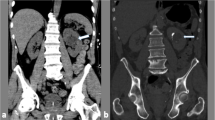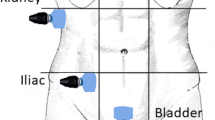Abstract
Purpose
Retrograde pyelography (RPG) is used in some centers to further evaluate patients with incompletely opacified segments on CT urography (CTU). This study intends to evaluate the utility of this imaging combination in terms of the yield of abnormal findings on the follow up RPG.
Methods
In this retrospective study, we searched the radiology database over a three-year period (11/1/2015–10/30/2018) for patients who had a CTU and then a diagnostic RPG within 180 days. Images and reports were reviewed from this period for patients who met the inclusion criteria.
Results
292 patients underwent a CTU with follow up RPG over the search period. 131/292 RPGs (44.9%) were performed because the CTU described at least one incompletely opacified ureteral segment. Of the 148 ureters evaluated in these 131 patients, 4 ureters (2.7%) showed an abnormality on follow up retrograde pyelogram—two revealed a stricture at the unfilled segment, and two revealed contour irregularity in the distal ureter (biopsy showed urothelial cell carcinoma in these two).
Conclusion
There is a relatively low yield for detecting ureteral abnormalities when a retrograde pyelogram is performed after a CTU to evaluate an incompletely opacified ureteral segment—2.7% in our study, with only two of these incompletely opacified segments containing urothelial cancer (1.4%). In these two cases, a ureteral abnormality was visible on the CTU and RPG would seem to have a very low yield for follow up of unopacified ureteral segments if the ureters are otherwise normal-appearing on CTU and there is no hydronephrosis.



Similar content being viewed by others
References
Metser U, Goldstein MA, Chawla TP, Fleshner NE, Jacks LM, O'Malley ME. Detection of urothelial tumors: comparison of urothelial phase with excretory phase CT urography–a prospective study. (2012) Radiology. 264 (1): 110-8.
Davis R, Jones JS, Barocas DA, Castle EP, Lang EK, Leveillee RJ, Messing EM, Miller SD, Peterson AC, Turk TM, Weitzel W. Diagnosis, evaluation and follow-up of asymptomatic microhematuria (AMH) in adults: AUA guideline. (2012) The Journal of urology. 188 (6 Suppl): 2473-81.
Commander CW, Johnson DC, Raynor MC, Burke LM, Hacker KE, Hoag B, Fielding JR, Semelka RC, Lee ER. Detection of Upper Tract Urothelial Malignancies by Computed Tomography Urography in Patients Referred for Hematuria at a Large Tertiary Referral Center. (2017) Urology. 102: 31-37
Rouprêt M, Babjuk M, Compérat E, Zigeuner R, Sylvester RJ, Burger M, Cowan NC, Gontero P, Van Rhijn BWG, Mostafid AH, Palou J, Shariat SF. European Association of Urology Guidelines on Upper Urinary Tract Urothelial Carcinoma: 2017 Update. (2018) European urology. 73 (1): 111-122.
Shen L, Raman SS, Beland MD, et al. ACR Appropriateness Criteria® Hematuria. Available at https://acsearch.acr.org/docs/ 69490/Narrative/. American College of Radiology. Accessed June 24, 2019.
Kekelidze M, Dwarkasing RS, Dijkshoorn ML, Sikorska K, Verhagen PC, Krestin GP. Kidney and urinary tract imaging: triple-bolus multidetector CT urography as a one-stop shop–protocol design, opacification, and image quality analysis. (2010) Radiology. 255 (2): 508-16
Potenta SE, D’Agostino R, Sternberg KM, Tatsumi K, Perusse K. CT Urography for Evaluation of the Ureter. (2015) Radiographics: a review publication of the Radiological Society of North America, Inc. 35 (3): 709-26
Hack K, Pinto PA, Gollub MJ. Targeted delayed scanning at CT urography: a worthwhile use of radiation? (2012) Radiology. 265 (1): 143-50
Siegel C. Re: Targeted delayed scanning at CT urography: a worthwhile use of radiation? (2013) The Journal of urology. 189 (6): 2090-1.
Xu AD, Ng CS, Kamat A, Grossman HB, Dinney C, Sandler CM. Significance of upper urinary tract urothelial thickening and filling defect seen on MDCT urography in patients with a history of urothelial neoplasms. (2010) AJR. American journal of roentgenology. 195 (4): 959-65.
Author information
Authors and Affiliations
Corresponding author
Ethics declarations
Conflict of interest
All authors declare that they have no conflicts of interest.
Ethical approval
All procedures performed in studies involving human participants were in accordance with the ethical standards of the institutional and/or national research committee and with the 1964 Helsinki declaration and its later amendments or comparable ethical standards.
Informed consent
A waiver for informed consent was granted by the institutional IRB.
Additional information
Publisher's Note
Springer Nature remains neutral with regard to jurisdictional claims in published maps and institutional affiliations.
Rights and permissions
About this article
Cite this article
Paspulati, A., Gupta, A., Hill, P. et al. The utility of retrograde pyelography to follow up incompletely opacified ureters on CT urography. Abdom Radiol 45, 807–811 (2020). https://doi.org/10.1007/s00261-019-02121-0
Published:
Issue Date:
DOI: https://doi.org/10.1007/s00261-019-02121-0




